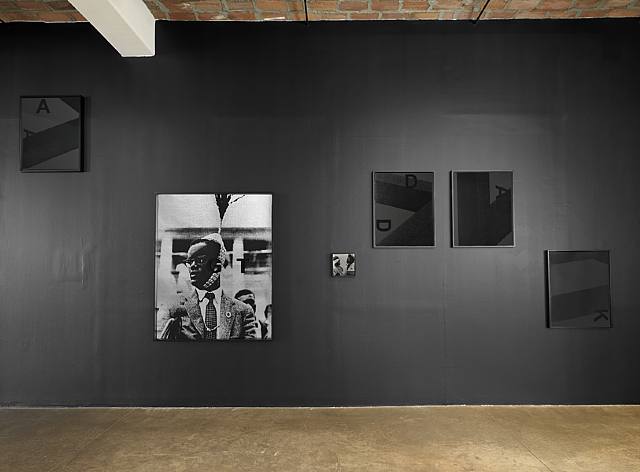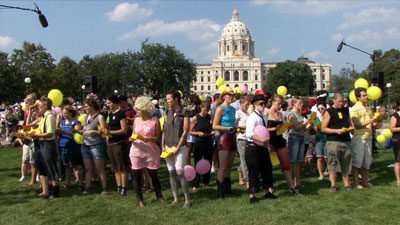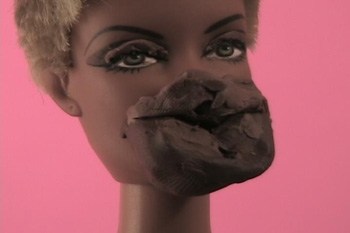II. After my visit to the New Museum, I headed uptown to the Studio Museum in Harlem. What stood out to me at the Studio Museum were a series of sculptural, photographic, and video works by Lauren Kelley, one of the museum’s 2009-2010 artists-in-residence. The photographic/sculptural works reminded me of works by Mike Kelley and (after Kelley) Catherine Sullivan and Matthew Barney. They did so for their sculpting (assembling? moulding?) of abstract plastic materials to form an abject, even alien-seeming, series of objects. A certain abject aesthetic also could be found in (Lauren) Kelley’s videos, which accompanied the sculptures and photographs of sculptural works.
In a series of three videos, all of which are animated, the artist gives us a glimpse into her middle-class African American background. In the first video, one sees a pool party circa late 70s/early 80s. The party-goers are represented by animated action figures covered in various ways by clay, somewhat like the animated figures of Nathalie Djurberg’s work. What is most refreshing about all three of the videos is how Kelley uses her materials, and how the mimetic (what resembles) is constantly foregrounding the thing-itself (the object being used to resemble). So when the figures splash in the pool, Kelley uses cellophane and bubble wrap to visualize the splashing. And when, in the second video, an airline stewardess sobs, one can see the smushed-together pieces of clay revealing a running mascara.
In Kelley’s videos, there is also a very effective use of traditional animation materials, such as clay, with props, such as a television set and a toy airplane. How, I was thinking during my viewing of Kelley’s videos, can one tell stories differently through animation? How, likewise, can animation be a way to encounter racism and classism, such as in the second video, which features a conflict between a black and a white airline stewardess, or an apocalyptic content, such as the third video, which features topiary animals becoming drenched in green slime, a la 80s Nickelodeon programs. Despite the fairly straightforward narratives of all three videos, the green slime was key to me, as it foregrounded an abjection I felt was present throughout Kelley’s residency works at the Studio Museum. And this abjection—stray pieces of brownish clay, or the distorted face of a crying airline stewardess—as in the work of a Djurberg (or a Fat Albert cartoon for that matter) sustained my interest and attention.
My last art destination this past weekend was PS.1.’s Greater New York show. Though I saw the show when it first opened (and meant to write about it then), I’m glad I am writing about it now after the smoke has cleared, the scathing reviews (such as this one) have been published, the verdicts passed, etc. A lot of works I had first seen in the show and not paid much attention to I had a new appreciation for, such as Leidy Churchman’s Painting Treatments, featuring bodies being covered in paint and other materials, and Ishmael Randall Weeks’s installation of architectural models and other architectural paraphernalia. But for the most part, I realized that there were a handful of works that I most wanted to return to and spend more time with, having had to speed through them during my first visit to the show.

Adam Pendleton's "The Abolition of Alienated Labor" at P.S.1 MoMA's "Greater New York" show. Courtesy Artnet.
At the risk of doing a “best in show” kind of thing, which is never my intention as an art writer, I want to briefly highlight a few works which impressed me, and reflect on why I thought they deserved more attention. Adam Pendleton, who I am currently working on an interview with for BOMB before his upcoming show at The Kitchen, has a wall in the show featuring one of his signature forms—the Systems of Display box-frames in which one encounters iconic images from art historical and radical political contexts silkscreened upon mirrors. Though I wish Pendleton’s installation could have been an entire room rather than a wall (an entire room would have better dramatized Pendleton’s painting the walls of his installation jet black), the scale and contrast of the Systems of Display box-frames was nevertheless dramatic, two of the box-frames being no less than 3 x 5 square feet and including the viewer’s full figure in their reflections.
Through the Systems of Display works, one has a sense of chiasmus — that one, in Maurice Merleau-Ponty’s definition of the term, is both seeing and seen, touching and being touched through an act of perception. Pendleton’s unique chiasmus has to do with history, and with historical materials as both archivable, iconic, and sensible. The intensity of Pendleton’s chiasmus is punctuated by an audio track playing just above the installation, Triptch, composed by Abbey Lincoln with Max Roach in 1960. In Triptch, Lincoln begins by humming. Gradually, her humming and singing ascends into a series of sustained screams, wails, and moanings redolent with the suffering of the Civil Rights era and of African-American history. What has this historic free jazz composition to do with the Systems of Display box-frames and the pictures that they project simultaneously with their viewer’s reflection? Pendleton’s works set-off a correspondence of blind spots which rest within and are wrested through the antagonism and ambivalence of present historical materials.
Another work in P.S.1’s GNY show that I was particularly drawn to was Deana Lawson’s Assemblage, a series of over a hundred 4 x 6.5 photographs pinned to the corner of a wall in a pixellated-ovular pattern. Standing in front of the wall for a while, I wondered what the photos had in common. Many of the snapshots were of black people, some famous and iconic (Puff Daddy, the Obamas, George Clinton), others seemingly anonymous. Amidst these photos were also ones of Nancy and Ronald Reagan, Kurt Cobain, The Police, three white teenagers holding beer funnels, funeral processions of various cultures, and depictions of medical subjects.
Relying on quality as much as scale, Lawson’s Assemblage pressures not only the relationship between private and public identities (since most of the photos are taken of celebrities and anonymous individuals in private settings, and the photos themselves resemble those one would have developed at an instant photo-mat before digital photography), but also between various biopolitical sites (the hospital, slave auction, school, etc.). With each snapshot, the viewer is newly interrogated not only by the gaze of the photograph (Where did this photo come from? Who took it? In what context may it have been originally published?), but with their own gaze (Who am I in relation to the subject of the photograph and the photographer?). Associations form among the photographs revealing surprising affects. A metaphysics of the body is present at every turn (What does it mean that this person is injured? That they are posed so? That one is looking at a memento mori of the body or that the body wounded becomes a kind of memento mori unto itself?). Principal among these photographs is a sense that the body is in danger; that it is vulnerable to harm, and to a play of forces within histories rather than a singular history.
Echoing my senses of Lawson’s Assemblage, was Sharon Hayes‘s room-sized, multi-channel video installation amidst pink and yellow balloons stenciled with the word “gay,” and various standing amplifiers. When I encountered Hayes’s video installation at the Whitney Biennial this past spring, Parole, I thought that it was by far the most accomplished work in the show, and that the ways it grappled with questions of the archive, historical representation, and collective vs. personal experience were both subtle, multi-faceted, and complex.
In Parole, one sees an androgynous (masculine) female figure carrying around a microphone and recording device. Various people get into the path of her microphone, and are therefore recorded; others give speeches and read texts into the microphone. In certain scenes we witness this figure interviewing people at a desk in an office; other times we see the figure listening to archived sound recordings. As the figure records and listens, yet is herself silent, she seems to me an allegory but of what exactly, I still wonder. Of the way that history becomes represented, inscribed, archived, effaced? Of the conditions of historical remembrance themselves? As though history, as a process, were itself silent, itself without speech. As if articulation were what surrounded a personal history’s speechlessness or ineffability.
In other scenes from Parole, one sees Hayes reading a correspondence between herself and a lover through a portable amplifying system. And this correspondence, too, seems an allegory of sorts. The lover is not just a lover, but as in Alain Resnais’s and Marguerite Duras’s Hiroshima Mon Amour, a kind of singularity—a point through which multiple social affects and attitudes coalesce. Do we make love with another person to produce what we will have wanted to have been?—that’s what these correspondences between Hayes and her imagined lover seem to ask.

Video still from Sharon Hayes's "Revolutionary Love: I Am Your Worst Fear, I Am Your Best Fantasy." Courtesy the artist.
And it is with this question that Hayes picks up with her installation at Greater New York, Revolutionary Love: I Am Your Worst Fear, I Am Your Best Fantasy, in which one finds assembled through multiple audio tracks and multiple video projections of different scales and vantages a scene of collective utterance in the name of gay rights and “revolution.” While Hayes’ work is clearly indebted to that of gay (and other) activist artists which have preceded her, such as Act-Up and Group Material, in historically reflective ways, Hayes is taking up the question of what a universal subject might look like in our present, a present in which activism would seem all but completely contained: “It’s not like the old days, when things were loose and you could flirt or lie your way in.”
While a universal subject is evoked by a crowd reading aloud a text written by Hayes during a rally in D.C., it is fractured by the various images of queer identities that Hayes projects simultaneously, very few of which synch up (neither literally in the video installation’s diegesis, nor figuratively in terms of their appearance). In Hayes’s work, a crucial dialectic is established between the singular and the multiple, but also between the desire of a univocal subject ever waiting to come into being and the inter-subjectivities which threaten totality by turning to the interior, private, and domestic—the solemnity, in particular, of the couple, whether queer or ostensibly “straight.” How to record this? The apartness that ensues after being in a lover’s arms or after one has been swept off-their-feet by collective endeavor? The feeling of being part of a singular identity, movement, or struggle? All of the works I have seen by Hayes so far iterate this problematic of personal and collective singularity in important and renewing ways.





